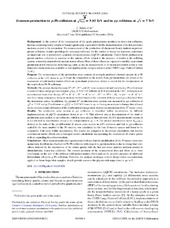D-meson production in \(p\)–Pb collisions at \(\sqrt{s_{\rm NN}}=5.02\) TeV and in \(pp\) collisions at \(\sqrt{s}=7\) TeV
Adam, Jaroslav; Adamová, Dagmar; Aggarwal, Madan M.; Aglieri Rinella, Gianluca; Agnello, Michelangelo; Agrawal, Nikita; Ahammed, Zubayer; Ahmad, Shafiq F.; Ahn, Sang Un; Aiola, Salvatore; Alme, Johan; Helstrup, Håvard; Hetland, Kristin Fanebust; Kileng, Bjarte; Altinpinar, Sedat; Djuvsland, Øystein; Lønne, Per-Ivar; Nystrand, Joakim; Rehman, Attiq ur; Røhrich, Dieter; Tambave, Ganesh Jagannath; Ullaland, Kjetil; Velure, Arild; Wagner, Boris; Zhang, Hui; Zhou, Zhuo; Zhu, Hongsheng; Arsene, Ionut Christian; Bätzing, Paul Christoph; Dordic, Olja; Lindal, Svein; Mahmood, Sohail Musa; Milosevic, Jovan; Qvigstad, Henrik; Richter, Matthias; Røed, Ketil; Skaali, Toralf Bernhard; Tveter, Trine Spedstad; Wikne, Jon Christopher; Zhao, Chengxin; Langøy, Rune; Lien, Jørgen André; Akindinov, Alexander; Alam, Sk Noor; De Albuquerque, Danilo Silva; Aleksandrov, Dimitry; Alessandro, Bruno; Alexandre, Didier; Alfaro Molina, José Rubén; Alici, Andrea; ALICE, Collaboration
Peer reviewed, Journal article
Published version

Åpne
Permanent lenke
https://hdl.handle.net/1956/16888Utgivelsesdato
2016-11Metadata
Vis full innførselSamlinger
Originalversjon
https://doi.org/10.1103/physrevc.94.054908Sammendrag
The production cross sections of the prompt charmed mesons D\)^0\), D\)^+\), D\)^{*+}\) and D\(_{\rm s}^+\) were measured at mid-rapidity in p-Pb collisions at a centre-of-mass energy per nucleon pair \(\sqrt{s_{\rm NN}}=5.02\) TeV with the ALICE detector at the LHC. D mesons were reconstruct ed from their decays D\)^0\rightarrow {\rm K}^-\pi^+\), D\)^+\rightarrow {\rm K}^-\pi^+\pi^+\), D\)^{*+}\rightarrow {\rm D}^0\pi^+\), D\(_s^+\rightarrow\phi\pi^+\rightarrow {\rm K}^-{\rm K}^+\pi^+\), and their charge conjugates. The \(p_{\rm T}\)-differential production cross sections were measured at mid-rapidity in the transverse momentum interval \(1<p_{\rm T}<24\) GeV/\(c\) for D\)^0\), D\)^+\) and D\)^{*+}\) mesons and in \(2<p_{\rm T}<12\) GeV/\(c\) for \(D_s^+\) mesons, using an analysis method based on the selection of decay topologies displaced from the interaction vertex. The production cross sections of the D\)^0\), D\)^+\) and D\)^{*+}\) mesons were also measured in three \(p_{\rm T}\) intervals as a function of the rapidity \(y_{\rm cms}\) in the centre-of-mass system in \(-1.26<y_{\rm cms}<0.34\), In addition, the prompt D\)^0\) production cross section was measured in pp collisions at \(\sqrt{s}=7\) TeV and p-Pb collisions at \(\sqrt{s_{\rm NN}}=5.02\) TeV down to \(p_{\rm T}=0\) using an analysis technique that is based on the estimation and subtraction of the combinatorial background, without reconstruction of the D\)^0\) decay vertex. The nuclear modification factor \(R_{\rm pPb}(p_{\rm T})\), defined as the ratio of the \(p_{\rm T}\)-differential D-meson cross section in p-Pb collisions and that in pp collisions scaled by the mass number of the Pb nucleus, was calculated for the four D-meson species and found to be compatible with unity within experimental uncertainties. The results are compared to theoretical calculations that include cold-nuclear-matter effects and to transport model calculations incorporating the interactions of charm quarks with an expanding deconfined medium.
